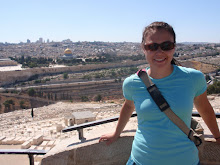
June 1
Orientation day. We didn’t have to get up as early as we were going to have to the rest of the trip. We had to be on the bus by 8 or 8:30, so we had time to eat breakfast at the Kibbutz hotel. I sat with a couple of people from the Truman group and two people from West Virginia, Becky and Brandon. As the week went on, we ended up being back of the bus buddies. The three of us and Lauren Greenspan would sit in the back of the bus every day to and from the dig-site. Occasionally other people would join us.
The introduction to the dig was interesting at first, but got to be a bit boring. First, they introduced all of the professors and then handed out name tags before going around the circle and having everyone say their names. Rami, the man in charge of the dig, gave us a brief history of both the site and the excavation. Turns out, the site is much older than the New Testament period. It was the main city of a kingdom during 8 and 9 centuries B.C.E. and was home of one of David’s wives. By the time of Jesus, it was a small fishing village and anywhere from 5 to 7 of his apostles were from this town. Gradually, however, as time when on, the lake receded and finally the shore was too far away for the village to be fruitful. People moved away, and the village was abandoned. It was completely lost for a while until some priest found it. He followed cows up a hill, I think, because there were land mines from the 1967 war between Syria and Israel. (Bethsaida used to be in Syria, but Israel took that land from them in 1967. So the dig might not be part of Israel anymore depending on how things work out over there…).
Having a history lesson by the Sea of Galilee was pretty cool. I definitely heard music coming from over the lake while Rami was talking. It was pretty moving to be sitting in a city Jesus visited often, looking over the Sea of Galilee and hearing music playing. Much more moving than the tank fire we heard from training camps during the rest of the week.
After the history lesson, Rami led us around the site showing us various places of interest. He showed us the high places in front of the city gates, the city gates and the roads. He explained part of what people would be working on during the next two weeks. A couple of groups would be working on making the area of the city gates more accessible for tourists. Another group would be working on the area in front of the city gates and a third group of about 10 would be working in the Roman Era Area under the direction of Dr. Elizabeth McNamer.
I kind of stopped paying attention by this point because it was hot, and I was tired and bored. We went back to Kibbutz for lunch, and in theory an afternoon to ourselves since pottery readings would not start until Wednesday afternoon (there was not enough pottery to warrant a reading at this point.) Instead of being given time to ourselves, Dr. Appold decided we should see the Jesus boat at 4. We were to meet in the lobby of the hotel and then go over to the Museum to see the boat. Very few people wanted to go that afternoon. We wanted to go on our own to see the boat when we wanted to instead of having our one free afternoon taken by him. He was, I think, actually late and we did not get away from the hotel until 4:45. By the time we got to the Museum, it was supposed to be closed. They did open up the gift shop for us but then Dr. Appold had us walk around the dark, closed museum for which most of the media presentations were not on.
There was a good side to all of this. We did manage to find free internet. We used a computer we probably shouldn’t have, and realized that there was a wireless router. This came in handy since several people in our group had brought laptops and the Kibbutz hotel charged an outrageous amount to use the internet over there.
A few of us hung out by the computer for a while, and then even fewer went up to the top of the museum to the look out area. It was really beautiful to look out over the Sea of Galilee. Then we had dinner and a lecture about Kibbutz living.

No comments:
Post a Comment